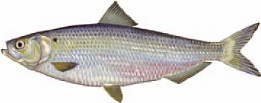 Scientific Name
Scientific Name
Alosa aestivalis
Other Common Names
river herring
Identification
Blueback herring and alewife are almost identical looking; the best way to tell them apart is an internal difference, blueback have a black membrane that lines the abdominal cavity and alewife have a light colored one with few, scattered spots. Blueback are bluish along the back with a silvery head; alewife is grayish- blue above, with a bronze head. Maximum length is 12 to 15 inches and less than 1 lb.
Best Fishing
It is now illegal for any person to have river herring in their possession, including blueback herring and alewife. For more information about this regulation, see the VMRC website.
Feeding Habits
Herring are pelagic, schooling and feeding in midwater or at the surface, preying on zooplankton, as well as shrimp, other small crustaceans, small fish, and fish eggs.
Habitat
Both blueback and alewife are anadromous, living in salt and brackish marine areas as adults and returning to freshwater to spawn. Alewife and blueback can spend their entire life in freshwater, with reproducing populations established in impoundments.
Spawning Habits
Alewife spawn earlier than blueback, with both migrating upstream in the spring like shad. Herring spawn in quieter, upper portions on streams and creeks, randomly releasing sticky eggs that sink and adhere to the bottom. The tiny eggs hatch in 2 to 3 days; young head for salt water when they are several months old.


